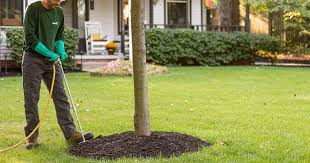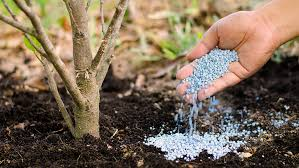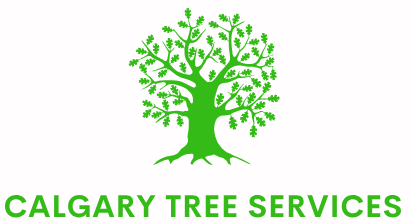Calgary Tree Services
Tree Fertilization Services
Like other living organisms, trees need water and nutrients to survive and the best way to ensure that your trees get enough nutrients is to fertilize them each year. The nutrients contained in fertilizer help your trees grow healthy and strong and give them better resistance against harsh environmental conditions, severe weather, and insect infestations and disease. You should make sure your trees are fertilized twice each year; once before the growing season in the spring and once in the fall to prepare them for the winter.
At
Calgary Tree Services, we provide fertilization services in and around the Kelowna area to properly fertilize trees on residential and commercial properties. We also offer a tree fertilization program in which we will regularly fertilize your trees when necessary. You can trust our professionals to apply fertilizer blends to your trees and shrubs that will help them grow strong and remain healthy.
CTS is dedicated to providing effective
tree maintenance
for your trees and both fertilization and
mulching
is an important part of this maintenance. You can get your trees on our fertilization program to ensure that we don’t miss an application at the beginning or end of the growing season. Our arborists will fertilize your trees with the proper blend to help them remain healthy and grow to their full potential.

Get Instant Quote
Contact Us
We will get back to you as soon as possible.
Please try again later.

Why Is Fertilization Important?
Fertilization holds significant importance due to the following reasons:
- Nutrient enrichment: Trees require a consistent supply of nutrients for optimal growth. Fertilization ensures they receive any necessary elements lacking in the soil.
- Stress tolerance: Well-fertilized trees and shrubs are better equipped to withstand environmental stressors, including extreme weather conditions, pests, and diseases.
- Enhanced aesthetics: Fertilization promotes lush foliage, vibrant colors, and overall plant vigor, enhancing the beauty and aesthetic appeal of your landscape.
How can I tell if my trees need to be fertilized?
When your trees are lacking the nutrients they need. You’ll see several symptoms:
- Stunted growth– When a tree can’t get all the nutrients it needs, it will slow its growth to conserve energy.
- Thin or patchy foliage– If a tree is lacking nutrients, it will cut off resources to twigs and branches to conserve energy.
- Yellow leaves– Nutrient deficiency shows up in a tree’s leaves, making them yellow instead of healthy green.
- Dropped leaves– Your tree may drop leaves during the growing season when it doesn’t have enough nutrients and food energy to support them.
- Insects and diseases– A stressed tree has fewer natural defenses and is more susceptible to attacks from insect pests and diseases.
When should I fertilize my trees?
Spring and fall are the best times for tree fertilization.
Benefits of Spring Fertilization
When you fertilize your trees in spring, you’re giving them a hand after a long, cold winter. If you’ve had your trees pruned during winter or if they’ve suffered damage from winter storms, in spring they will start using their limited energy stores right away to seal off wounds. Spring fertilizing helps ensure your trees have enough nutrients for maximum leaf and flower growth. This means you’ll have vigorous trees that will give you summer shade and healthy crops of fruit.
Benefits of Fall Fertilization
After a long growing season, your trees start to wind down their activity in fall. Fertilizing your trees in fall will help them build up their energy stores to carry them through winter. (You won’t see any growth above ground during winter, but tree roots never sleep!).
The key to fertilization is timing
For example, adding nitrogen to your trees in winter will do nothing because, trees are dormant and not producing leaves, (this can also be a good time to trim & prune) and frozen ground means water-soluble fertilizer won’t reach tree roots. Also your trees need fertilizer at certain points in their annual growth cycles; at other times the fertilizer will be wasted. The best time to fertilize your trees is right when they need it.
Do newly planted trees and shrubs need fertilizer?
- In most landscapes, healthy trees and shrubs do not require fertilizers, especially when they reach their mature size.
- It is not recommended to fertilize at planting time. Research studies show most of a plant’s energy is directed to root growth during the establishment period. The application of nitrogen during this period seems to suppress root growth rather than enhance it.
- Trees and shrubs absorb nutrients applied to adjacent turfgrass.
- Fertilizer is not a remedy for landscape problems. Get your soil tested if you expect a nutrient deficiency. Most trees and shrubs prefer a soil pH (acidity level) of 5.5 - 7.0.
- Proper watering of newly planted trees and shrubs is the most important maintenance practice for establishing plants.
- Never fertilize a drought-stressed plant.
Fertilizer types
Fertilizers are identified by a guaranteed analysis (product label) such as 10-6-4 or 5-10-5. The three numbers represent the percentages by weight of nitrogen (N), phosphate (P2O5), and potash (K20), respectively, contained in the fertilizer.
Complete analysis granular fertilizer
A fertilizer with the three major plant nutrients, nitrogen, phosphorus, and potassium, is called a complete fertilizer. Commonly used complete fertilizers for trees and shrubs have a ratio of 3:1:1. We will select a fertilizer that supplies the nutrients your plant needs without over-supplying unnecessary nutrients. If your soil test indicates levels of phosphorus and potassium are adequate we will only need to apply nitrogen. However, it is often harder to find a nitrogen-only granular fertilizer. As an alternative, we might select a fertilizer with low amounts of phosphorus and potassium. Secondary nutrients like calcium, magnesium, and sulfur are sometimes included in fertilizers.
Slow-release nitrogen
This form of nitrogen is supplied slowly over a relatively long period of time. It is usually more expensive than the more common water-soluble (fast release) nitrogen, but less likely to contribute to nutrient pollution of our water resources. Slow-release nitrogen is available at a uniform rate over the entire season. Many tree and shrub fertilizers are a combination of slow-release and quick-release sources of nitrogen.
Organic fertilizers and compost
These can be substituted for chemical fertilizers. Using shredded leaves (run collected leaves over with a lawnmower) to mulch trees and shrubs provides a slow release of nutrients as the leaves break down and eliminate the need to purchase mulch. Compost can also be used but don’t apply more than a 1-inch layer.
Tree Fertilization Methods
Our arborists will use one of two main application methods to fertilize your trees and shrubs; soil injection and direct injection. We will determine the best method of fertilization based on the condition of your trees.
Soil Injection
For this method, we use a special tool that injects fertilizer directly to the root system deep in the soil. This method works best when the soil is compacted, and it puts the nutrients deep enough to ensure that they reach the tree roots with little competition from the grass roots. We will assess your trees and shrubs to determine the right blend of macro and micro nutrients in the fertilizer.
Direct Injection
With this method, the fertilizer is injected directly into the vascular system of the tree. This is the most effective way to give your trees 100 percent of the necessary nutrients. We will use direct injection fertilization if your trees have a nutrient deficiency.
What is tree fertilization?
Tree fertilization involves providing essential nutrients to support their growth and development. Fertilizers contain a combination of macronutrients (such as nitrogen, phosphorus, and potassium) and micronutrients (such as iron, zinc, and manganese) necessary for their overall health.
How will I know if my tree should be pruned?
If you have trees, chances are you need to fertilize them. Trees that grow in forests and woodlands get their nutrients from the soil they grow in, but the soil in urban and suburban areas is nothing like native soils. Here’s how it’s different:
Soil is Compacted
Tree roots struggle to grow in compacted soil because they can’t penetrate the heavy material. Water either runs off compacted soil or collects and doesn’t drain.
It’s Really Subsoil, Not Topsoil
When developers build urban and suburban areas, they may use the subsoil from excavation as landscape soil. Unlike topsoil, this subsoil has few to no nutrients in it and can’t support healthy tree and plant growth.
Soil is Depleted
In undisturbed forests, fallen leaves, twigs, and fruit collect on the ground. All this nutrient-rich organic matter breaks down into the soil for tree roots to use. Sadly, in urban areas, this is all raked up and thrown away.
What happens to trees that aren’t fertilized?
Your tree will keep trying to grow even when it’s lacking vital nutrients, but its long-term health won’t be good. The combination of stunted growth and chronic nutrient stress during growing seasons will shorten its lifespan significantly.
Many homeowners compound the problem by mistaking the signs of nutrient deficiency for water stress and overwatering the tree. Or they over-prune thinking this will stimulate more growth (it won’t).
How much does tree fertilization cost?
fertilization cost depends on how many trees need to be fertilized and what kind of fertilizer your trees need. Contact us for a free quote today.
Which type of fertilizer should I use for trees?
If you’re not sure about what kind of fertilizer your trees need, don’t guess. You could be doing more harm than you think. Both the wrong kind of fertilizer and the wrong amount will have negative effects.
Different types of trees have different needs.
We can come and inspect your trees and recommend the right fertilizer for the job.
Is it possible to use too much fertilizer?
Over-fertilization is very much a thing.
If you’re a homeowner buying packaged fertilizer, follow the instructions on the label. More is not better!
Signs of over-fertilization
When you give your tree too much fertilizer, you’ll see several symptoms, including:
- Brown leaf edges or leaf tips
- Yellow, limp leaves
- Leaf drop
Of course you can always call us as we have a lot of experience with fertilization and know the exact amount to use.
All Rights Reserved | Calgary Tree Services
